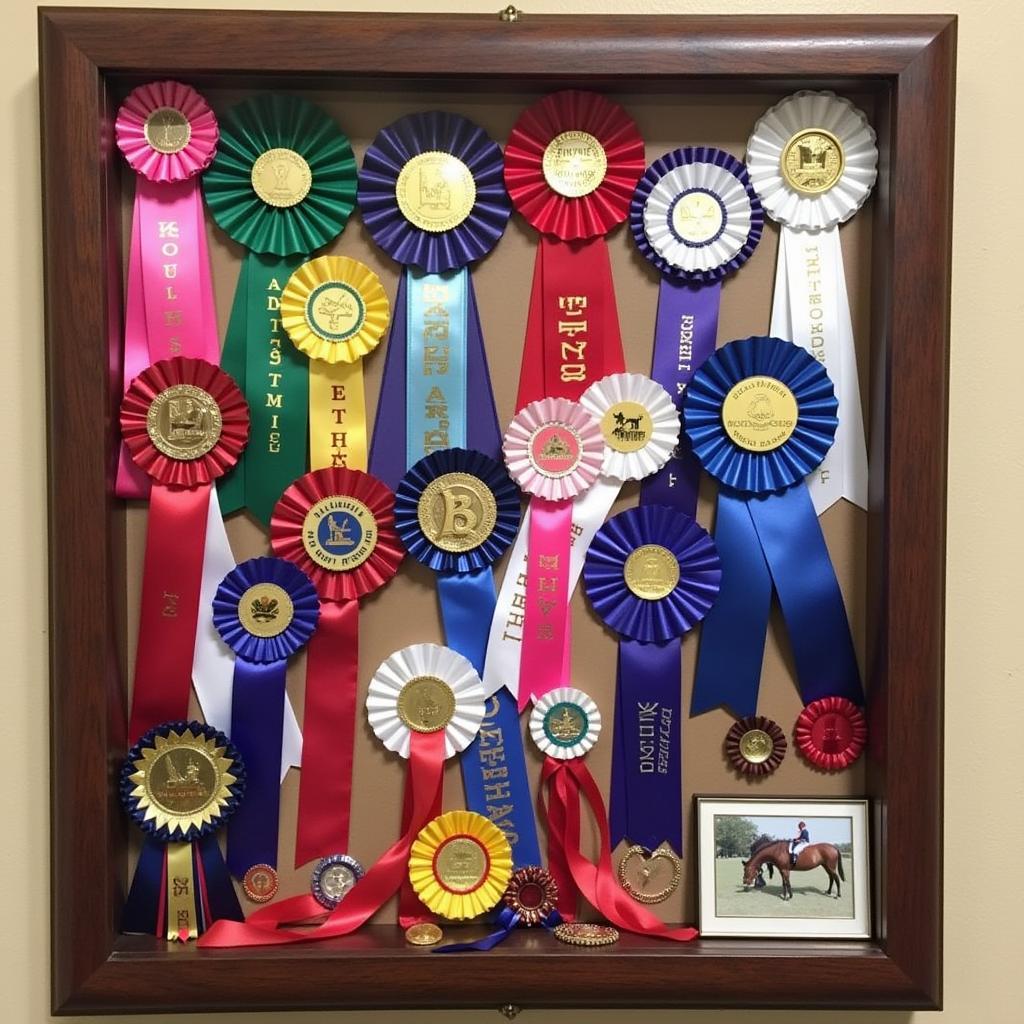Horse Ribbons are more than just decorative accessories; they are symbols of pride, dedication, and the special bond between horse and rider. Whether fluttering from a bridle or displayed proudly in a collection, these colorful tokens represent hours of training, unwavering teamwork, and moments of triumph in the equestrian world.
Decoding the Language of Horse Ribbons
Like a secret code, horse ribbons communicate a wealth of information to those who know how to read them. The color, design, and even the way a ribbon is worn can reveal the type of competition, placing achieved, and sometimes even the specific discipline within the equestrian world.
Color Codes and Their Significance
From vibrant blues and reds to elegant greens and purples, each ribbon color often corresponds to a specific placing or achievement. While variations exist across different organizations and disciplines, some common color associations include:
- Blue: Frequently signifies first place, symbolizing victory and excellence.
- Red: Often represents second place, acknowledging a strong performance.
- Yellow: Commonly denotes third place, celebrating a commendable effort.
- White: Can indicate various meanings depending on the context, such as sportsmanship, participation, or a special award.
- Green: Often associated with fourth place.
- Purple: May signify fifth place or a specific achievement in certain disciplines.
It’s important to note that these are just general guidelines, and specific color meanings can vary. Always refer to the event’s rules and regulations for precise interpretations.
Beyond the Colors: Designs and Details
In addition to color, the design and details on horse ribbons can provide further insights:
- Text and Logos: Ribbons often feature printed text or embroidered logos that specify the event name, organization, date, or class.
- Rosettes: Circular decorations, known as rosettes, often adorn the top portion of the ribbon, adding a touch of elegance and tradition.
- Tail Ribbons: Smaller ribbons, sometimes called “horse tail ribbons,” can be braided into a horse’s tail as a mark of honor or to signify participation in a specific class.
Horse Ribbons Across Disciplines: A Glimpse into the Equestrian World
From the precision of dressage to the thrill of jumping, the equestrian world encompasses a diverse range of disciplines, each with its unique set of traditions and ribbon meanings.
Show Jumping: A Test of Skill and Agility
In show jumping, horses and riders navigate a course of obstacles, aiming for clear rounds and fast times. Ribbons in this discipline often reflect:
- Faults: The number of penalties incurred for knocking down rails or exceeding the time limit.
- Jump-offs: Special rounds held to determine the winner if multiple horse-and-rider pairs complete the initial course without faults.
Dressage: The Art of Equestrian Elegance
Dressage showcases the harmony and partnership between horse and rider through a series of precise movements and patterns. Ribbons in this discipline might indicate:
- Percentage Scores: Judges award numerical scores based on the accuracy and execution of each movement, with higher scores indicating better performance.
- Levels: Dressage competitions are divided into levels of increasing difficulty, with ribbons often signifying the level at which the horse and rider competed.
 Collection of Horse Show Ribbons in a Shadow Box
Collection of Horse Show Ribbons in a Shadow Box
Beyond the Arena: Recognizing Versatility and Achievement
Horse ribbons aren’t limited to competitive events. They also celebrate achievements in:
- Breeding: Awards for conformation, temperament, and offspring quality.
- Trail riding: Recognizing horsemanship skills and trail etiquette.
- Therapeutic riding: Celebrating the bond between horse and rider in therapeutic settings.
Caring for Horse Ribbons: Preserving Memories and Tradition
Whether you’re a seasoned competitor or a proud horse owner, caring for your horse ribbons ensures these treasured mementos stand the test of time.
- Cleaning and Storage: Gently hand-wash ribbons with mild detergent, air dry them thoroughly, and store them in a cool, dry place to prevent fading and damage.
- Displaying Your Collection: Showcase your ribbons proudly in shadow boxes, on display racks, or by incorporating them into creative home decor projects.
Horse Ribbons: A Tapestry of Equestrian Passion
From local shows to prestigious championships, “horse show ribbon“s tell stories of dedication, partnership, and the pursuit of excellence. They serve as a reminder of the unique bond between horse and human, the thrill of competition, and the timeless allure of the equestrian world.
FAQs:
1. What do you do with old horse ribbons?
Don’t discard them! Consider repurposing them into crafts, using them for scrapbooking, or donating them to therapeutic riding centers.
2. What does a yellow ribbon mean in horse riding?
While meanings vary, yellow often signifies third place in many competitions.
3. How do you display horse show ribbons?
Get creative! Use shadow boxes, display racks, bulletin boards, or incorporate them into home decor items.
4. Where can I find information about specific “horse competition ribbons“?
Refer to the rulebook or website of the organization hosting the competition for detailed information about ribbon meanings.
5. Do the “horse tail ribbon colors” have specific meanings?
In some disciplines, yes. For example, a green ribbon braided into a horse’s tail might indicate the horse is a kicker. Always consult the show’s rules or ask an official for clarification.
For additional information and resources on horses and equestrian care, explore more articles on JustusHorses.com. Discover fascinating insights into the world of “wooden hobby horse“s or browse our wide selection of equestrian products.
Need personalized advice or assistance? Don’t hesitate to contact our dedicated team at Phone Number: 0772127271, Email: [email protected], or visit us at QGM2+WX2, Vị Trung, Vị Thuỷ, Hậu Giang, Vietnam. Our 24/7 customer service team is always ready to help you.